The Gilpin Tram in Black Hawk
12



12
|
Thoroughly enjoyed reading this thread about Gilpin Tram.
Question about warming building. My son and I are making a trek to Colorado this June. We are going to Black Hawk/ Cnetral City to look at Polar Star Mill. Is the warming building foundations or anything left to see? |
|
See Image #9 in the first post. All remains have been covered in the construction of a parking lot.
Chuck |
Re: The Gilpin Tram in Black Hawk
|
Whew! It’s been a while since I posted. Time to get back on track…
But, continuing along on our visit to upper Black Hawk, we come up to the transfer tracks between the Gilpin Tram and C&S. 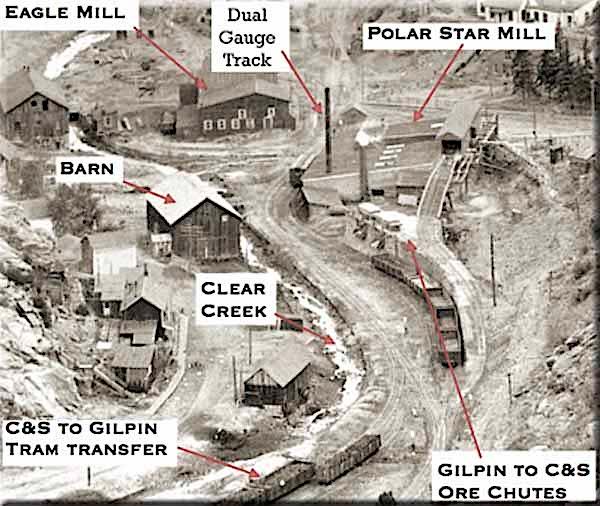 This enlargement of the previously photo zooms in on the Gilpin Tram and C&S freight transfer. There are two C&S coal cars parked on the siding, next to two Gilpin Tram coal cars. The C&S coal cars will be unloaded by hand shoveling into the Gilpin Tram coal cars. Empty C&S coal cars are parked on the siding next to the ore chutes, and will be filled one-by-one from Gilpin ore cars above. The loaded cars will be coasted down on the slight gradient, and the next car then loaded. The narrow valley of Clear Creek took a slight bend to the west, and just around the corner were the freight transfer tracks from the 3’ gauge C&S to the 2’ gauge Gilpin Tram. The accompanying figures show the simple track arrangement – 2 parallel sidings where freight was hand-transferred from the 3’ gauge to the 2’ gauge. I think most of the freight was coal for the mines – it was delivered in 3’ gauge gondolas (coal cars) and then shoveled into both Gilpin Tram ore cars and specially-built wooden coal cars. This was a moderately busy place - records from October 1907 show 15 C&S cars of coal were transferred to the Gilpin Tram that month. But, some of the Gilpin County mines were early innovators, switching to electrical power when possible, and by the early 1900s, using internal combustion engines for power, thus gradually reducing the need for coal. 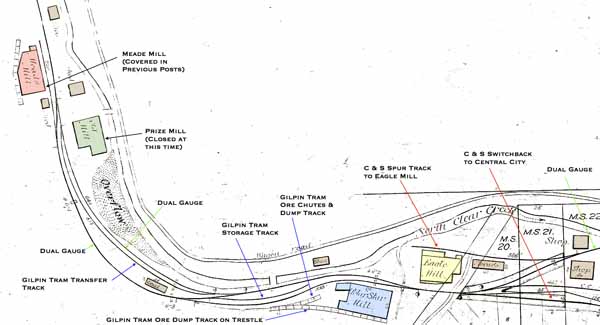 This track map is enlarged from a C&S track map from the Colorado Historical Society collection. The Gilpin Tram transfer track is very close to the Polar Star Mill Although a very basic arrangement, a surprising variety of non-coal traffic transferred off the C&S to the Gilpin Tram. This traffic was sporadic, and coincided with construction of new mines or rebuilding, with at least one shipment going from a mine to the “depot”. From surviving Gilpin Tram records and local newspaper accounts, here is some of the transfer traffic I could locate: This is just the traffic documented in August and October 1907: “Merchandise” (not described any more than that), in shipments varying from 0.14 to 0.66 tons, and hauled in ore cars to the East Pewabic and Pewabic Mines Steel”, 1.666 tons in ore car 141 to the Pewabic Mine Drill steel, 4.09 tons to the Pewabic Mine in Car 4 (a coal car) A casting (not described) of 0.1 tons in ore car 139 from the Pewabic Mine to the depot area “Oil” in ore car 136 to the East Pewabic Mine (must have been in cans or barrels) Steel (not described) of 2 tons in coal car 4 from the Pewabic Mine to the depot area Iron pipe, 0.92 tons from the depot area to the Old Town Mine in coal car 4 “Powder” in ore cars 45 & 48 – 11.45 tons of it! This was from the depot area to the Old Town Mine 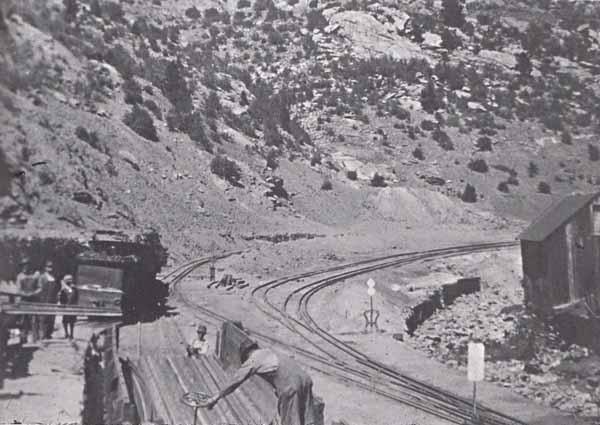 This is a photo from the Ronzio collection, and published in the Gilpin Railroad Era. There is a lot of detail in this photo but it is the best photo showing the C&S-Gilpin coal and transfer tracks. This photo was taken when the Gilpin Tram and shut down and was being scrapped - that is torn-up rail inside the C&S gondola in the foreground. Note the dual gauge track at right - the 2' gauge Gilpin Tram track is to the left of it. The "mainline" is the dual gauge track at far left (in front of the shay). One interesting detail here - the turnouts to 2' gauge track are all thrown with harp switch stands, and any dual gauge turnout is thrown with rotary switch stands. I wonder what color the switch stand targets were painted? 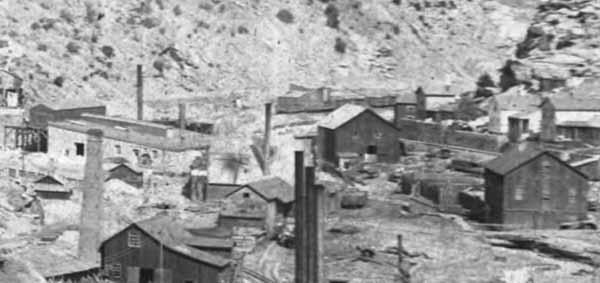 Here is a view from the Denver Public Library, Western History Collection, greatly enlarged from a small corner of a photo. The south side of the Polar Star Mill can be seen at left, along with the Gilpin Tram ore spur for unloading (track is on a trestle). In the center (blurry) distance, some C&S cars can be seen parked on the transfer track. I love this scene showing how crowded together the buildings are - there seems to be smokestacks and buildings everywhere! 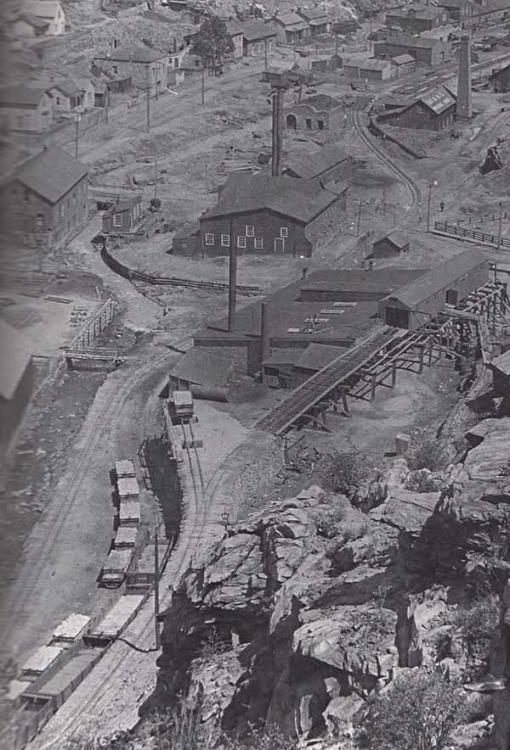 This photo is a Ronzio collection photo from the Gilpin Railroad Era. Of interest here is the 2' gauge Gilpin Tram spur to the ore chutes, and the trestle for unloading ore into the Polar Star Mill. At the ore chutes, there are 4, 3' gauge C&S gondolas waiting to be loaded with ore from the ore chutes. One Gilpin Tram ore car sits on the ore chute dump track above. There are 8 loaded Gilpin Tram ore cars to the left of the C&S gondolas. They are sitting on a 2' gauge track that seems to be use for ore car storage while waiting to be unloaded. Immediately above the Polar Star Mill is the Eagle Mill. The Eagle Mill was served only by the C&S, and never by the Gilpin Tram. There was a lot of interesting switching activity around the ore chutes and transfer track. This information is from C&S records in the Colorado Railroad Museum archives. Some moves that were documented in 1907: Transfer of C&S cars 4858, 4106, and 4037 from the Hidden Treasure Mill to the C&S Transfer Switching C&S cars 7625 and 4065 from the Polar Star Mill to the C&S Transfer Other car switching was of C&S gondolas 4226, 4245, 4895 and 4140 in October 1907, from the Hidden Treasure Mill to the C&S ore chutes. These switching moves refer to switching of 3’ gauge gondolas by the Gilpin Tram, on the dual gauge track.
Keith Pashina
Narrow-minded in Arizona |
Re: The Gilpin Tram in Black Hawk
|
A LOOK AT THE POLAR STAR MILL
The Polar Star Mill was literally right next to the ore transfer chutes. The transfer chutes were built to easily dump smelter-quality ore that was going into C&S gondolas for shipment elsewhere. The ore mined along the Gilpin Tram tended to be divided into mill-grade ore (lower metal values), and the cars of smelter ore (higher grade) . I speculate the ore chutes were located here because of a convenient space for a 2’ gauge spur and because the track was up on a trestle already, to reach the Polar Star Mill. Photographs from the era show that the ore chutes were built from timber, and later mostly filled in with dirt and rock. The chutes were just that – a metal trough where Gilpin Tram ore cars dumped directly into a waiting C&S gondola below – there was no storage bin or chute gate. A pair of ore chutes was constructed, spaced for two Gilpin Tram ore cars, and the entire ore chutes spur was only long enough for two ore cars. Very simple, compact, and an ideal scene to model. 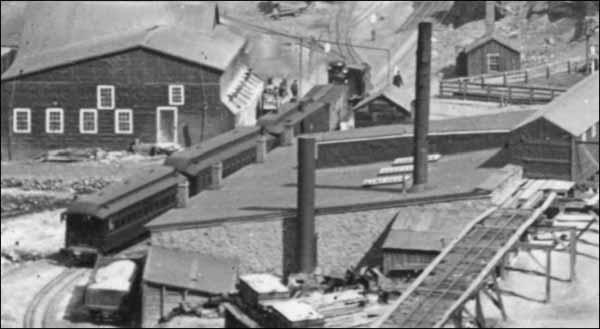 This enlargement of a photo is from the Denver Public Library, Western History Collection. A C&S passenger train to Central City is passing the Polar Star Mill. A loaded C&S gondola may have been loaded from the ore chutes, and dropped by gravity to in front of the Polar Star Mill. There are 2 loaded Gilpin Tram ore cars sitting on the ore chutes track, waiting to be dumped into C&S gondolas. The trestlework at right supports the Gilpin's 2' gauge unloading spur. The doors are shut on the structure where the cars were unloaded. This structure is actually a warming shed, heated by steam pipes in winter for thawing frozen ore in the Gilpin cars The Polar Star Mill is a distinctive structure, still standing today. The Polar Star Mill actually is the 2nd structure on this site, and replaced an earlier wooden mill, and was likely built in the 1870s. The existing mill is a simple structure, with stone walls and a post and beam-supported sloping roof. Unlike what we think as a “typical” mill, the Polar Star Mill was built on a relatively level site and does not have the typical cascading construction of a building constructed on the side of a hillside, The mill walls are about 2’ thick rough stonewalls, mortared together with local stone on the nearby mountainsides. The Polar Star Mill was built before construction of the Gilpin Tram, so when the tramway was built, the spur to the mill was built on a wooden trestle above the driveway for horse-drawn wagons to also deliver ore to the mill. That same trestle also had a warming shed for thawing out frozen ore cars in the winter, before dumping into the mill. 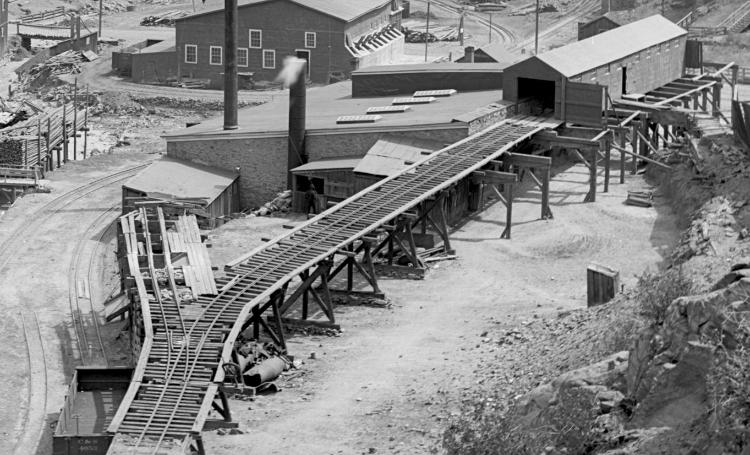 Here is a closer view of the ore chutes as originally built. The trestle work on the approach and ore chutes spur were later infilled with soil and rock walls. Note the simple metal chute for dumping ore into C&S cars. 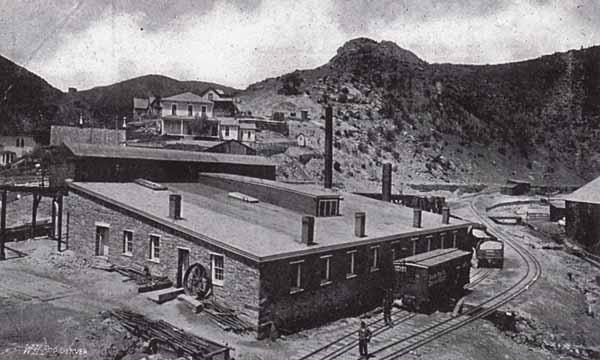 This view is from the Ronzio collection, and published in the Gilpin Railroad Era. A UPD&G boxcar is parked on the dual gauge track in front of the Polar Star Mill. Two or more loaded 3' gauge gondolas can be seen behind it. This is also a nice view of the south end of the Gilpin Tram unloading trestle and warming shed. 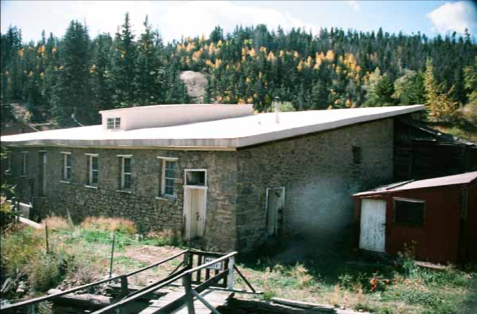 Here is the Polar Star Mill about 25 years ago. It is privately owned by the Blake family, and has been in that family for many decades. This is a wonderful example of stone wall construction. The present roof is a new membrane, and not the original roof material (I don't know what the original roof covering was). The present owners worked with a Colorado preservation group, and a grant repointed the stone walls, replaced the roof, and other work to restore and protect the building. 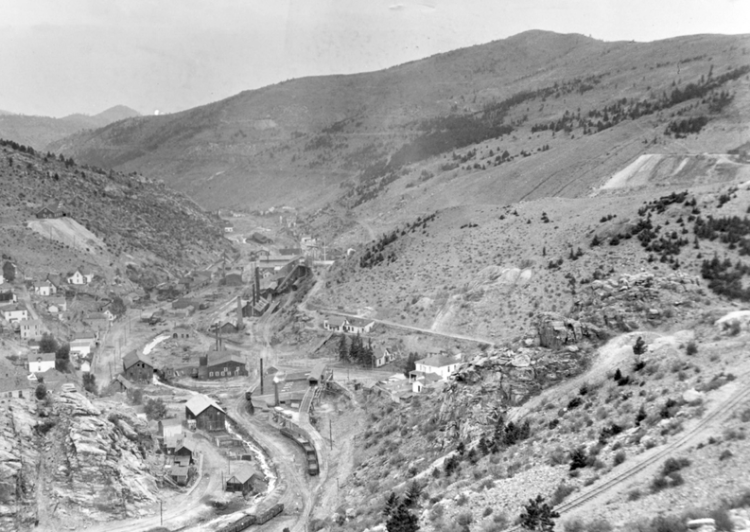 In this photo, the bottom center of the photo shows a string of 5, C&S coal cars parked on the siding next to the ore transfer chutes. Two Gilpin Tram ore cars can be seen on the ore transfer trestle above, still loaded. At the bottom center photo edge, two C&S coal cars are parked on the siding next to the Gilpin Tram transfer - two Gilpin coal cars are parked on the track where coal was hand shoveled from the 3' gauge to the 2' gauge. Black Hawk lies in the valley beyond the Polar Star Mill.  This is a similar view to the previous photo, showing Black Hawk 23 years ago. There has been even more casino development and construction since then. A lot has changed in the past 100 years. However, the Polar Star Mill still stands - it can be seen with the light-colored roof, immediately above the green-roofed municipal building in right foreground 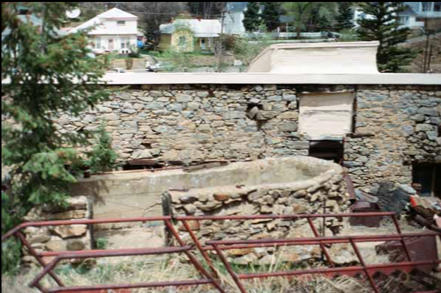 This view is looking east at the west wall of the Polar Star Mill. The bathtub-shaped stone enclosure in the foreground was the end of the water flume, which diverted water for Clear Creek during high creek flows, and was used to power an interior water wheel that powered the stamps and machinery 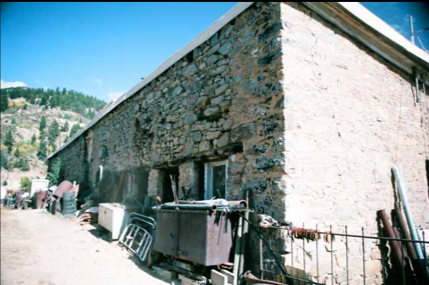 This is the business side of the Polar Star Mill - the Gilpin Tram ore trestle would have been on the left side of this photo, above the "road". The small doors on this wall are for unloading ore into the mill. The Polar Star Mill predates the construction of the Gilpin Tram. The ore trestle for the 2' gauge spur was a late addition, and an unusual ore chute arrangement was used to unload ore cars - I will explain in more detail, later 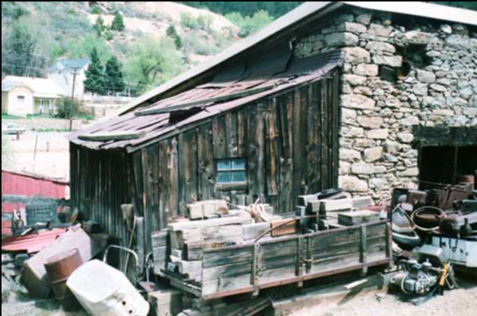 This is the northwest end of the Polar Star Mill, about 15 years. I had special permission from Norm Blake, then his son Kent, to be on the their property to photograph the mill. This little wood addition was possibly a stable for mules/horses 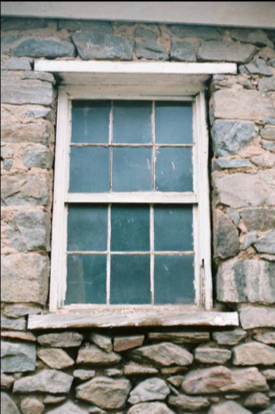 This view shows the stacked stone construction, mortared together. This photo was taken about 15 years ago, before a recent repair/restoration of the mill building. The eroded mortar joints have since been repointed. Note the heavy wooden window sill, and lintel at the top of the window. The stone walls are about 2' thick, so the lintels and sills are built of heavy wooden boards laid side-by side How big was the Polar Star mill? Well, the 1902 Mining Reporter Magazine reported the mil was operating 40 "slow-drop" stamps, and had a capacity of 40 tons per day. That equates to about 4 to 5 Gilpin Tram ore cars, but this mill also received ore from wagon teams, so this makes the mill a very-modelable size. 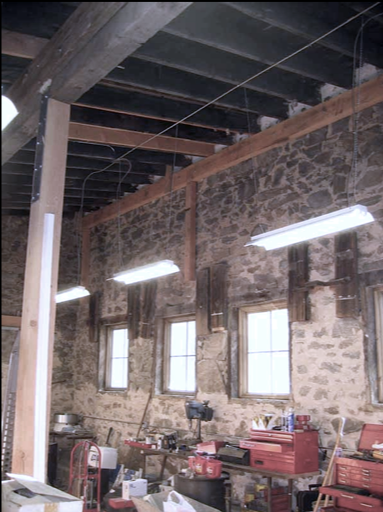 This view shows the inside of the Polar Star, after historic restoration. The mortared stone walls are clearly visible. The current owner uses part of the mill as a workshop 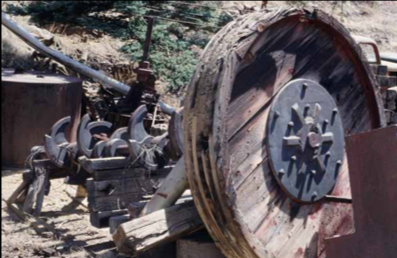 About 30 years ago, the Blake family had several parts of mill machinery laying on the ground next to the Polar Star Mill. Norm Blake told me in about 1992 that this cam and bull wheel were from a slow-drop stamp originally from the Randolph Mill (which is further south along Clear Creek and the subject of a future post) 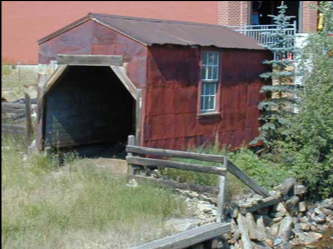 This little shed was modified by the Blake family and used as a donkey barn when I first saw it in 1990. Norm Blake told me at one time, this little structure was the mill office for the Randolph Mill 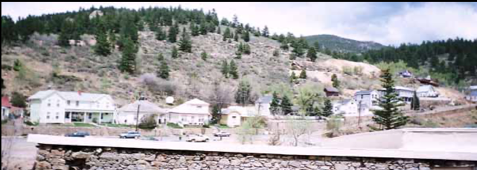 This photo is looking east, looking over the Polar Star Mill building. Black Hawk residences, many which date back 100 years or more, are on the opposite side of Clear Creek. The home at far left was the Blake home, and apparently has been in their family since the late 1800s
Keith Pashina
Narrow-minded in Arizona |
Re: The Gilpin Tram in Black Hawk
|
THE GOLDEN GILPIN MILL
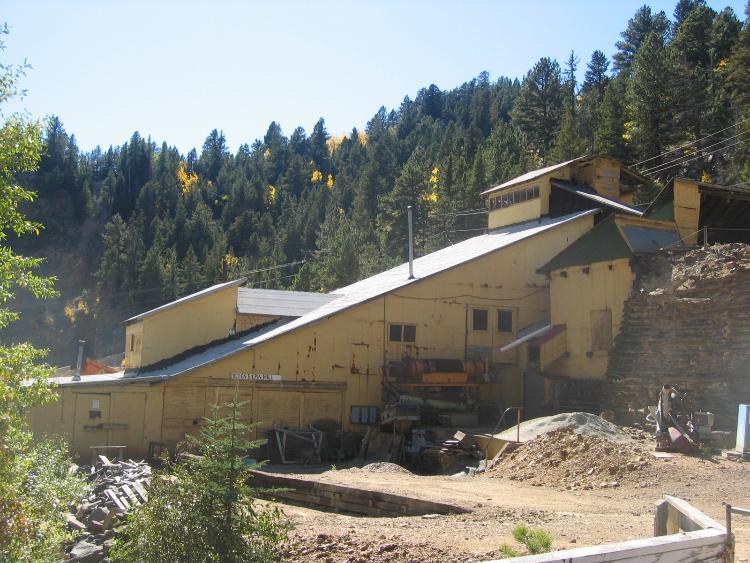 When you drive into Black Hawk, you see the Golden Gilpin mill building just north of the Polar Star Mill. This mill post-dates the Gilpin Tram period, and is a relatively modern addition. I think it was built in the 1930s -1950s era. An interesting structure, but too modern if you model the Gilpin Tram. The mill is currently active, too, and recently rehabilitated to process ores from a mine in nearby Mountain City. EAGLE MILL The Eagle Mill was located across the tracks and just a little bit south of the Polar Star Mill. There is not too much information I have been able to find out about this mill. This mill had 35 fast-drop stamps, and a capacity of 75 tons of ore per day. Compare this to the Polar Star Mill, which although the buildings were of similar size, had a capacity of only 40 tons per day with its 40 slow drop stamps. I do not know when it was built or when it ceased operations. In 1917, Bastin reported in his USGS report that the mill had been owned by the same company that operated the Next President Mine in Gregory Gulch, and their ore was treated by this mill. I do not know if this mill processed other mills' ores, or was used only by the one mine. The Next President Mine was located alongside the Colorado and Southern Railway branch to Central City. It was not directly served by the C&S, and I believe all the ore was teamed by wagon down to Black Hawk.  I'll post this map again, so you can reorient yourself to where we are in Black Hawk. 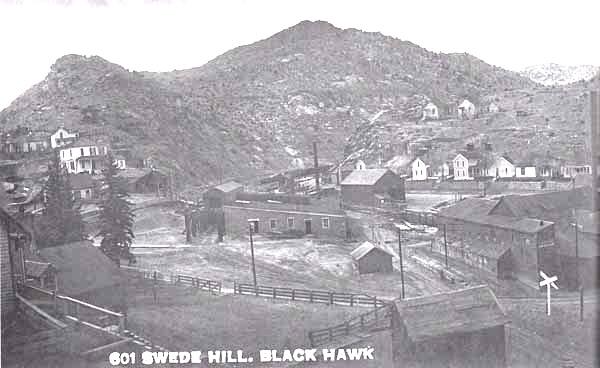 This is a Ronzio view from Gilpin Railroad Era. We are looking north at the Polar Star Mill at center, and the Eagle Mill is on the right hand edge of the photo, just above the white-painted railroad crossing sign 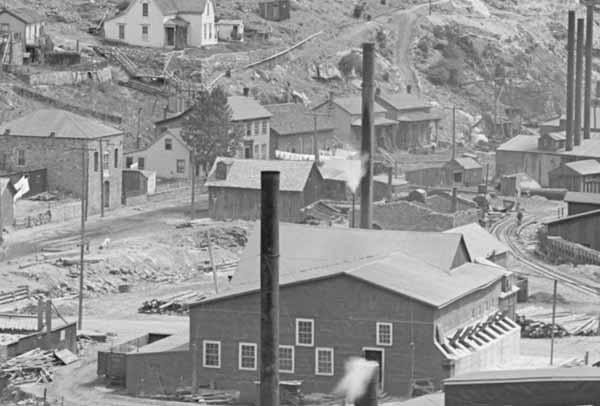 The Eagle Mill had a C&S 3' gauge spur on its east side. A C&S gondola can be seen on the left side of the mill, and probably had unloaded a load of coal. On the right side of the mill, there are 8 small hatches that are open - these doors are in the open position, and where wagons would be unloaded by hand-shoveling the ore into the receiving bins 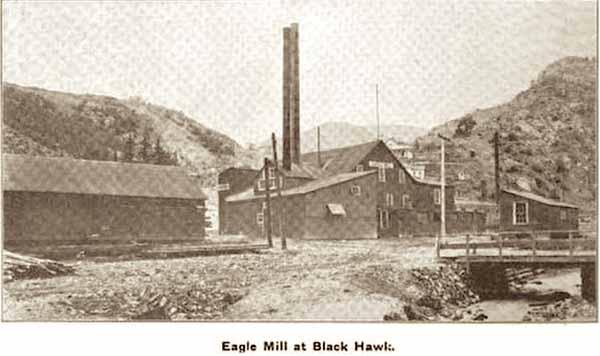 This is a view of the Eagle Mill from the 1907 Mining Investor Magazine, and shows the south (downstream) side of the mill. This photo was taken later than the previous photo, and the ore unloading bin doors are now covers by a building addition. The dual gauge C&S-Gilpin Tram trackage wound its way between the mill and the barn-like building at the left 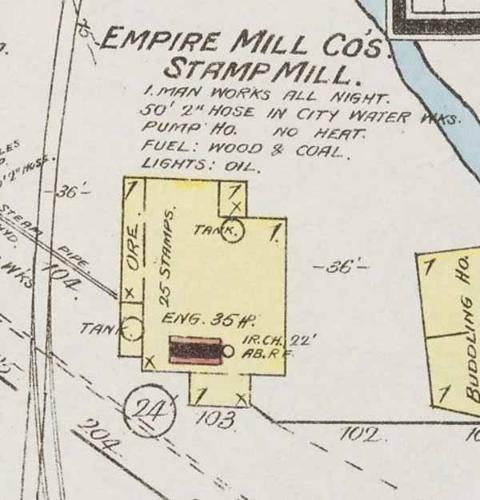 Here is the Sanborn Fire Insurance map showing the Eagle Mill at about the turn of the last century. The steam pipe crossed the tracks and served a City water pumping station. The track shown was actually dual gauge 2' and 3' trackage 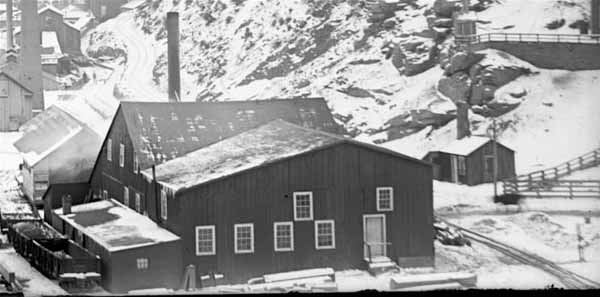 This view is from the Denver Public Library, Western History Collection, and shows the north (upstream) side of the Eagle Mill. Two C&S gondolas are parked on the coal unloading spur - one car has been unloaded and the other one appears partially unloaded. The dual gauge Gilpin Tram and C&S track appears on the right side of the mill. In the background can be seen part of the 50 Gold Mines Mill 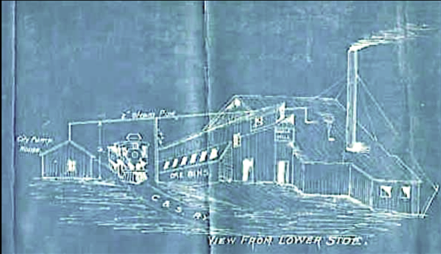 This drawing is from an accident report where a worker was struck and killed when switching by the Eagle Mill - they struck the steam pipe support for the steam line going to the City water pump house. There is a lot of information about this incident in Darel Leedy's C&Sng Discussion Forum, posted February 15, 2015, by Doug Heitkamp. If you go to the link, A Bad Day In Black Hawk Or How I Lost My Head! you can read all about this incident. This image was taken from that blog post 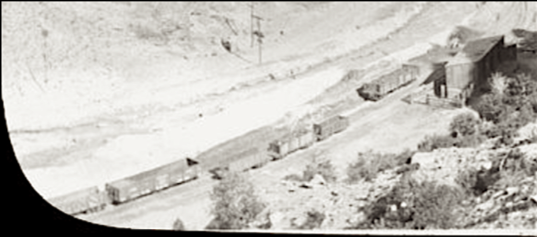 Last, I wanted to post this image, originally posted by Todd Hackett in the C&Sng blog in a previous post. This is a similar image to one I posted previously, but shows a nice, slightly different view of the C&S-to-Gilpin Tram transfer. Three Gilpin Tram coal cars are on the siding. The left-most one has the end panel lowered prior to loading. There are three C&S gondolas parked on the transfer track. You can see the barn or similar structure that was located between the transfer area and the dual gauge "mainline" track So, this little tour has looked at the Gilpin Tram engine house, yards, Fullerton Mill Branch, and the mills and transfer along Clear Creek down to just above the 50 Gold Mines complex and "downtown" Black Hawk. There is so much more to look at - there is the Black Hawk main town area, depot, and four more stamp mills and a sampling works that were all served by the Gilpin Tram. Plus, more C&S stuff! I have this material all filed away in my "round tuit" file, so watch for future posts.
Keith Pashina
Narrow-minded in Arizona |
|
Administrator
|
In reply to this post by Keith Pashina
Keith, thank you so much for taking the time to put all this together and post to this Forum. Pretty much anything I know about the Gilpin Tram, I know from your work here, and I really appreciate it. I'm sure I am not alone in this regard.
Mike |
«
Return to C&Sng Discussion Forum
|
1 view|%1 views
| Free forum by Nabble | Edit this page |

